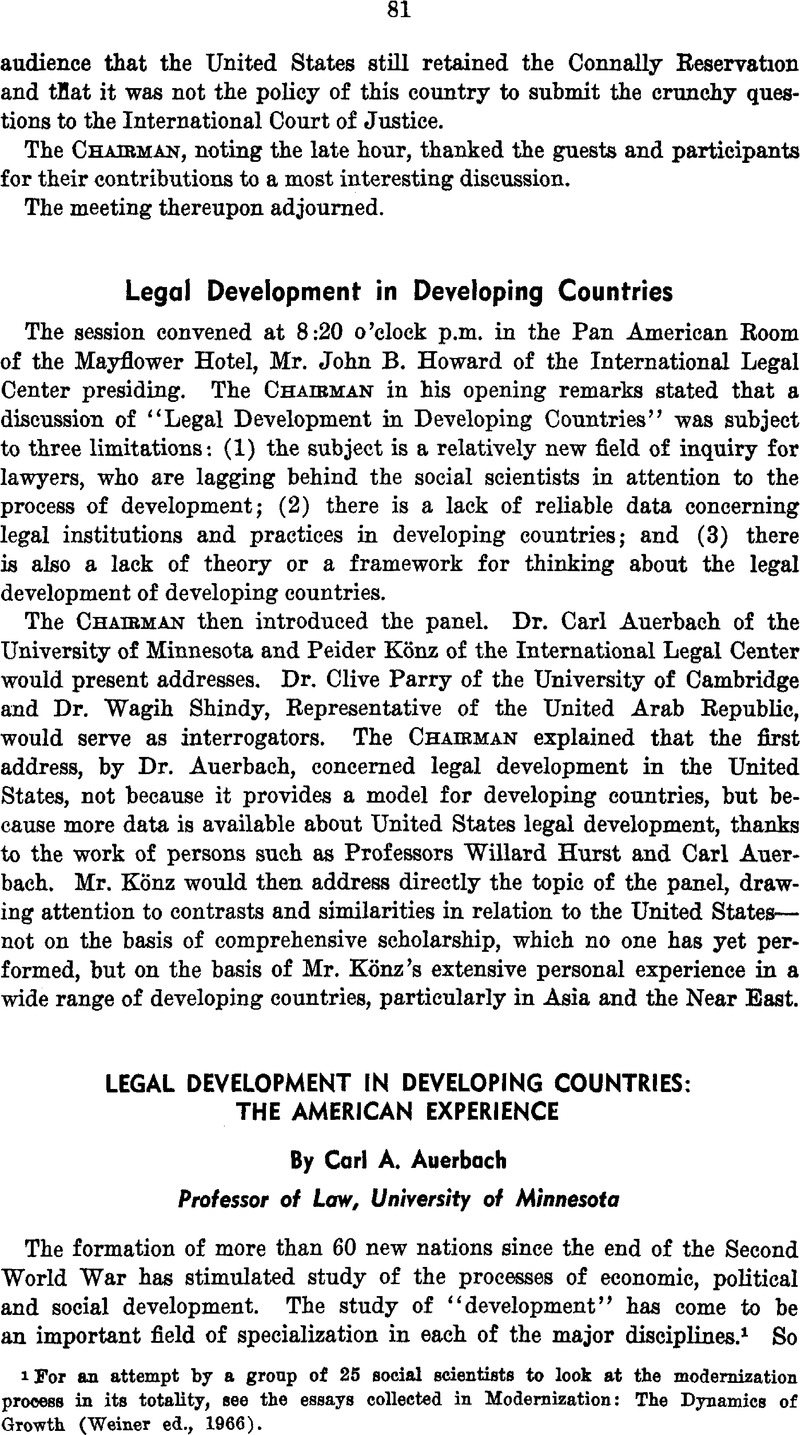No CrossRef data available.
Article contents
Legal Development in Developing Countries: The American Experience
Published online by Cambridge University Press: 27 February 2017
Abstract

- Type
- Perspectives for International Legal Development
- Information
- Copyright
- Copyright © American Society of International Law 1969
References
1 For an attempt by a group of 25 social scientists to look at the modernization process in its totality, see the essays collected in Modernization: The Dynamics of Growth (Weiner ed., 1966).
2 See Hurst, Law and Economic Growth: The Legal History of the Lumber Industry in Wisconsin 1863–1915 (1964); Law and Social Process in United States History (1960); Law and the Conditions of Freedom in the 19th Century United States (1956); and The Growth of American Law: The Law Makers (1950).
3 Lipset, The First New Nation: The United States in Historical and Comparative Perspective (Doubleday Anchor, 1967).
4 Parsons, “Evolutionary Universals in Society,” 29 Amer. Soc. Eev. 339 (1964), reprinted in Parsons, Sociological Theory and Modern Society, Ch. 15 (1967). The quotation (original italics) is from the latter work at 511.
5 Parsons, Sociological Theory and Modern Society 510 (1967).
6 Ibid. at 514. See also Galanter, “The Modernization of Law,” in Modernization: The Dynamics of Growth, op. cit. note 1 above at 153–165. Professor Galanter further delineates the attributes of an “ideal-type” or model modern legal system which is like Parsons’ universalistic legal order. Judged by Galanter's model, the process of law modernization is still going on in the United States. See ibid, at 157. Yet the essential attributes of the model were incorporated in the legal system with which the United States began its life in 1789.
7 Lipset, op. cit. note 3 above, at 19.
8 Ibid, at 20.
9 Ibid, at 21.
10 Ibid, at 25.
11 Ibid, at 104–105.
12 Ibid, at 106.
13 Ibid, at 108–109.
14 Ibid, at 30.
15 Bell, “Notes on the Post-Industrial Society,” The Public Interest, No. 6 (Winter, 1967), p. 24, and No. 7 (Spring, 1967), p. 102.
16 Boorstin, The Americans: The Colonial Experience 205 (1958).
17 Ibid.
18 Lipset, op. cit. note 3 above, at 86.
19 Ibid, at 52.
20 Polanyi, The Great Transformation (1944).
21 Rezneck, “The Else and Early Development of Industrial Consciousness in the United States, 1760–1830,” 4 J. Econ. & Bus. Hist. 784–785 (1932), cited in Lipset, op. cit. note 3 above, at 52.
22 Galbraith, The New Industrial State 184–197 (1967). The quotations are at 187.
23 Bell, “The Theory of Mass Society,” 22 Commentary 75 (1956).
24 Galbraith, The Affluent Society 78–97 (1958). The quotations are at 82.
25 Parsons defines an “evolutionary universal” as “a complex of structures and associated processes the development of which so increases the long-run adaptive capacity of living systems la a given class that only systems that develop the complex can attain certain higher levels of general adaptive capacity.” Op. oit. note 5 above, at 493.
26 Ibid, at 514. Title IX of the Foreign Assistance Act, 22 TJ.S.C. §2218 (1967), reflects Congress’ belief that the democratic association is an “evolutionary universal.” See Butler, “Title IX of the Foreign Assistance Act: Foreign Aid and Political Development,” 3 Law & Society Eeview 115 (1968).
Parsons suggests that four complexes together constitute “the structural foundations of modern society”—“bureaucratic organization of collective goal-attainment, money and market systems, generalized universalistic legal systems, and the democratic association with elective leadership and mediated membership support for policy orientations.” Ibid, at 518, 519. It is clear that the other foundations could not stand without a universalistic legal system, as Parsons emphasizes.
27 Bell, Social Change: A Conspectus of Theories, Concepts and Distinctions in Macrosociology (an unpublished paper prepared for a Bussell Sage Seminar, Nov. 21, 1968).
28 Hurst, Law and Social Process in United States History 3–5 (1960).


